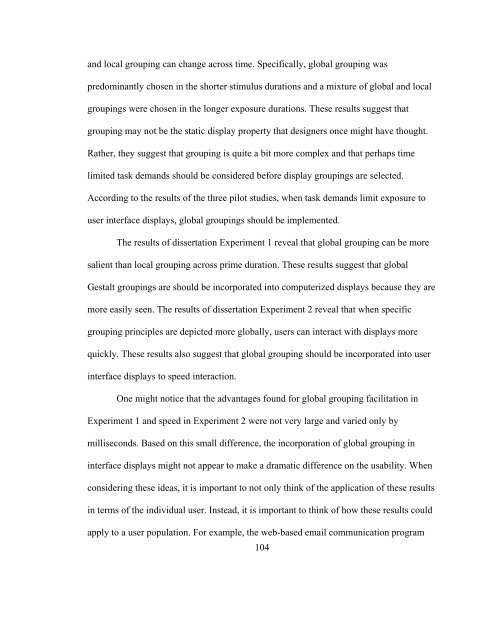The Use of Iambic Pentameter in the
The Use of Iambic Pentameter in the
The Use of Iambic Pentameter in the
You also want an ePaper? Increase the reach of your titles
YUMPU automatically turns print PDFs into web optimized ePapers that Google loves.
and local group<strong>in</strong>g can change across time. Specifically, global group<strong>in</strong>g was<br />
predom<strong>in</strong>antly chosen <strong>in</strong> <strong>the</strong> shorter stimulus durations and a mixture <strong>of</strong> global and local<br />
group<strong>in</strong>gs were chosen <strong>in</strong> <strong>the</strong> longer exposure durations. <strong>The</strong>se results suggest that<br />
group<strong>in</strong>g may not be <strong>the</strong> static display property that designers once might have thought.<br />
Ra<strong>the</strong>r, <strong>the</strong>y suggest that group<strong>in</strong>g is quite a bit more complex and that perhaps time<br />
limited task demands should be considered before display group<strong>in</strong>gs are selected.<br />
Accord<strong>in</strong>g to <strong>the</strong> results <strong>of</strong> <strong>the</strong> three pilot studies, when task demands limit exposure to<br />
user <strong>in</strong>terface displays, global group<strong>in</strong>gs should be implemented.<br />
<strong>The</strong> results <strong>of</strong> dissertation Experiment 1 reveal that global group<strong>in</strong>g can be more<br />
salient than local group<strong>in</strong>g across prime duration. <strong>The</strong>se results suggest that global<br />
Gestalt group<strong>in</strong>gs are should be <strong>in</strong>corporated <strong>in</strong>to computerized displays because <strong>the</strong>y are<br />
more easily seen. <strong>The</strong> results <strong>of</strong> dissertation Experiment 2 reveal that when specific<br />
group<strong>in</strong>g pr<strong>in</strong>ciples are depicted more globally, users can <strong>in</strong>teract with displays more<br />
quickly. <strong>The</strong>se results also suggest that global group<strong>in</strong>g should be <strong>in</strong>corporated <strong>in</strong>to user<br />
<strong>in</strong>terface displays to speed <strong>in</strong>teraction.<br />
One might notice that <strong>the</strong> advantages found for global group<strong>in</strong>g facilitation <strong>in</strong><br />
Experiment 1 and speed <strong>in</strong> Experiment 2 were not very large and varied only by<br />
milliseconds. Based on this small difference, <strong>the</strong> <strong>in</strong>corporation <strong>of</strong> global group<strong>in</strong>g <strong>in</strong><br />
<strong>in</strong>terface displays might not appear to make a dramatic difference on <strong>the</strong> usability. When<br />
consider<strong>in</strong>g <strong>the</strong>se ideas, it is important to not only th<strong>in</strong>k <strong>of</strong> <strong>the</strong> application <strong>of</strong> <strong>the</strong>se results<br />
<strong>in</strong> terms <strong>of</strong> <strong>the</strong> <strong>in</strong>dividual user. Instead, it is important to th<strong>in</strong>k <strong>of</strong> how <strong>the</strong>se results could<br />
apply to a user population. For example, <strong>the</strong> web-based email communication program<br />
104

















